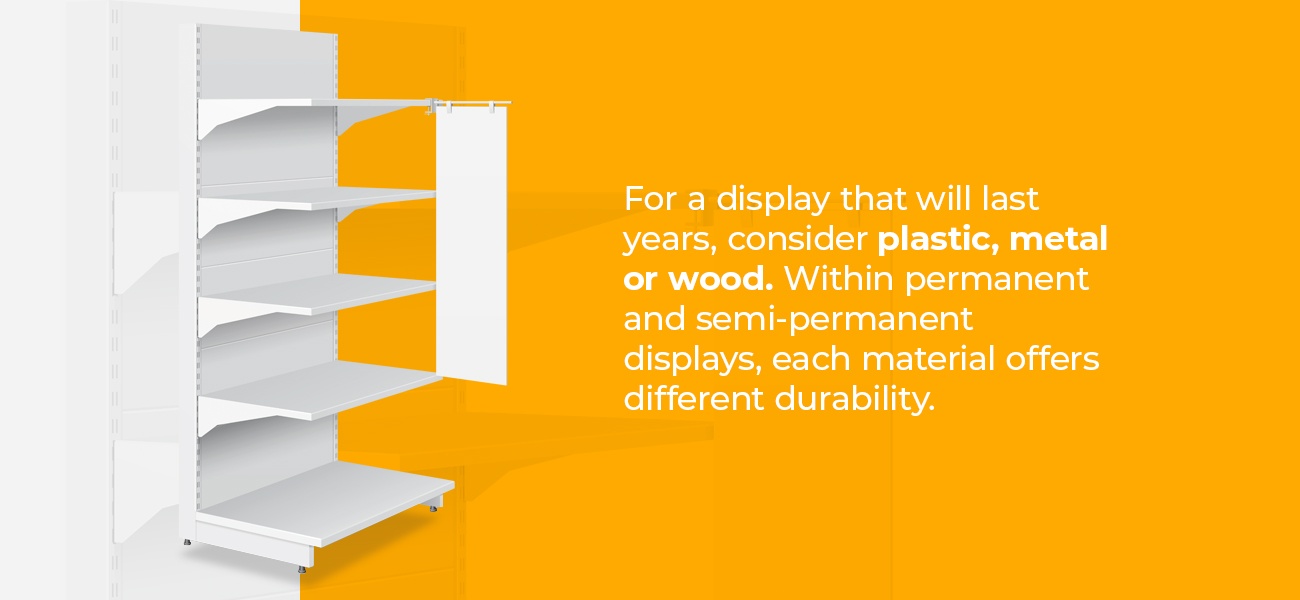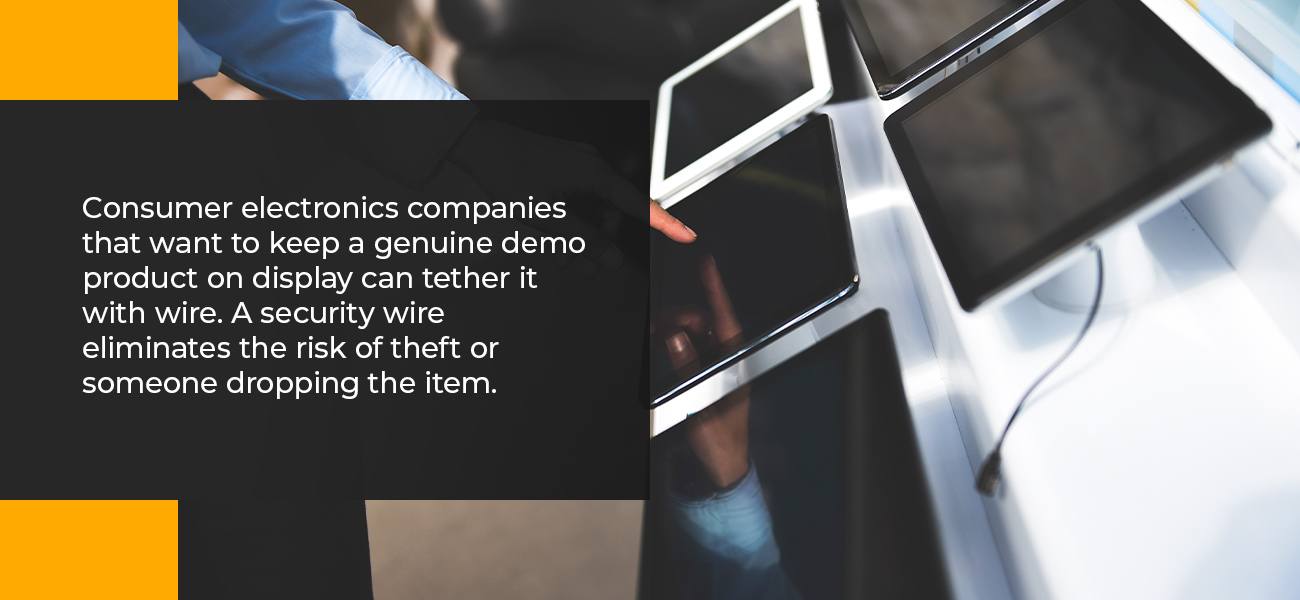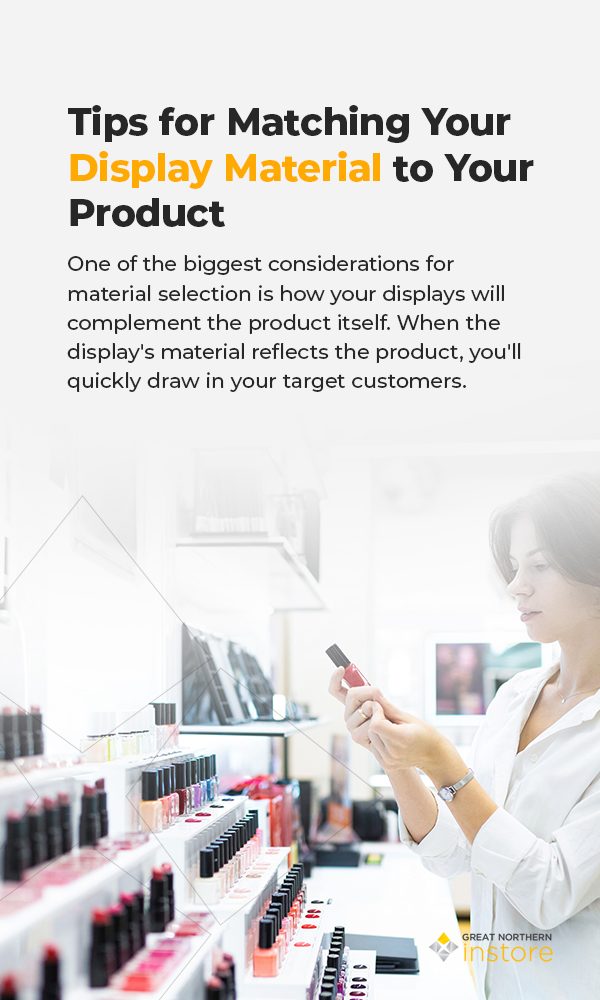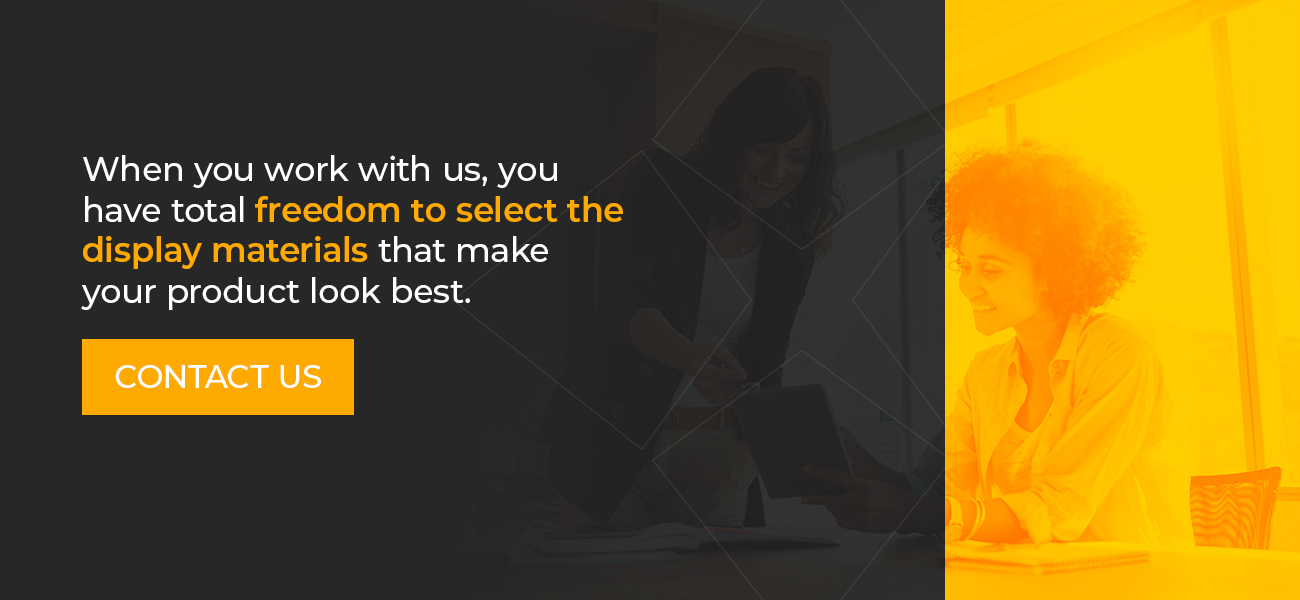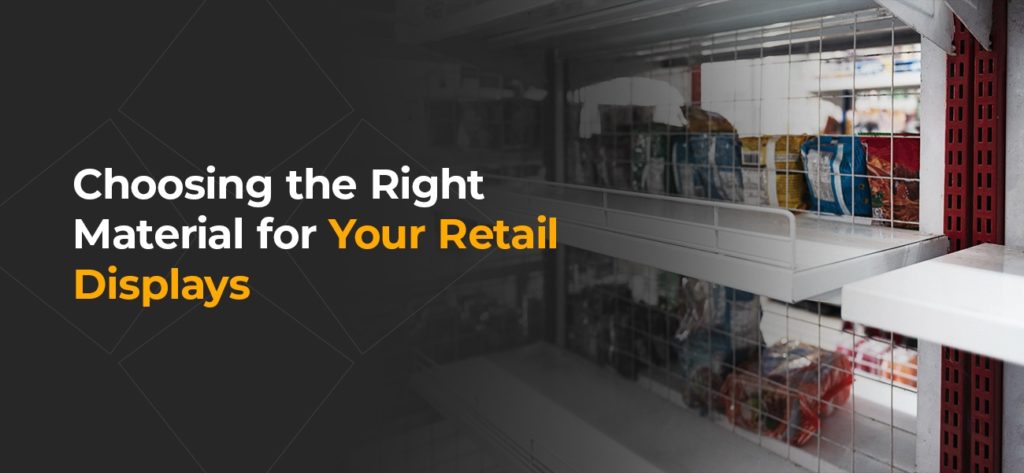
Point of purchase (POP) displays are an excellent way to help brands encourage impulse buys, introduce new products and increase sales. Designing an effective display involves many decisions. One of the critical initial choices is choosing which materials you’ll use. A suitable material can be the difference between a successful campaign and one that misses the mark. After all, each option contributes to branding and the impressions consumers have towards your products. The construction can also determine how long your display will last in stores.
Choosing the right material for your display is critical. Here are a few factors to consider in your selection.
Table of Contents:
Cost
When choosing retail display materials, one of your top concerns is the upfront costs. Each material can affect the overall engineering and manufacturing costs in different ways. In general, corrugate or cardboard is the most cost-effective. Since cardboard displays are lightweight, they’re more affordable to package, store and ship. Cardboard made from post-consumer materials will also add to their cost-effectiveness. After cardboard, plastic is the next step up. Plastic blends affordability with durability for permanent fixtures. As another lightweight option, it’s also fairly inexpensive to ship. Custom displays made out of cardboard or plastic will require up-front tooling costs for the molds and dies to form and cut the shapes for the display.
Wire racks are another cost-effective option for companies who want to use metal. More complex metal designs may cost more. However, some types of metals are malleable and easy to bend into unique designs. The cost of a wood display will depend on the type of wood and finishes required.
While cost-effectiveness is always important, some product marketers want to invest more in their POP displays. Choosing a more expensive material option will offer higher quality and durability. Shoppers will see the difference when they stop by your exhibit in the store. The right display material can communicate the quality or luxuriousness of the products it shows off.
A higher-end retail display can include interactive electronic components. Tablet displays, touch screens and lights add excitement and interactivity to your displays. The added investment comes with excellent return on investment (ROI). Interactive displays deepen shoppers’ connections with your products. After playing with a product matching quiz or watching videos of your product in action, they’re more likely to add it to their carts. These features can have the dual benefit of attracting shopper attention and educating them.
At Great Northern Instore, we know that every brand has different POP budgets. Our designers can value engineer a retail display using any material. We’ll find the unique blend of materials that will look good and increase sales that also meets your budget and hits your goals.
Durability
For durability, the main question to ask yourself is how long the display needs to last. Is it a temporary display for your latest promotion or a permanent installation? Corrugated cardboard is sturdy enough to withstand daily wear and tear for several months. It’s excellent for limited-time promotions. The low-cost and low-durability material makes it easy to customize your designs with the season or as new sales and promotions roll out. Our engineers can even design robust solutions with corrugated cardboard that can last for several months.
For a display that will last years, consider plastic, metal or wood. Within permanent and semi-permanent displays, each material offers different durability. Plastic offers excellent longevity for semi-permanent displays. This feature makes it the better option for a longer-term setup over cardboard. After a few years, plastic can show signs of fading and cracking. If the display must last even longer, consider metal or wood. Depending on the thickness, type and finish, wood makes an excellent semi-permanent and permanent display option. Metal displays can last for many years with the proper upkeep.
Movement
A display that’s easy to move is beneficial for many reasons. There are two types of movement to consider: logistics through the supply chain and the ability to be portable in the retail environment. First, a well designed display helps the assembly, packing and shipping logistics get more manageable. You’ll likely save on transportation costs if your designs are easy to load and unload. Then, once your displays are in your retailer’s hands, a portable design improves flexibility. If your display is underperforming in one section of the store, you can move it mid-campaign. Portability lets you keep moving your displays until you find the placement that maximizes sales.
Easy-to-move displays can offer faster assembly. Some brands prefer to ship their structures disassembled for cost savings and simpler logistics. To pull this off effectively, your displays need intuitive and straightforward assembly. A lightweight POP display is easier to get out onto the sales floor.
Cardboard requires no heavy lifting. Through the packaging, stocking, shipping and assembly process, it remains easy to transport. The ease of assembly and movement also improves retailer compliance. When store workers can assemble and move your cardboard display without strain or difficulty, they’re more likely to set it up how it was intended.
While cardboard is lightweight, it also requires care to avoid damage. If this is a concern, consider plastic displays. While still a lightweight option, plastic is more rigid. Acrylic panels or components can snap into place, making them easy for store employees to construct. Since they’re more durable, plastic displays are less likely to become damaged during handling.
Metal is also easy to assemble. A metal wire display may unfold into its intended structure. Wire structures are also lightweight and easy to rearrange as needed. Other metal displays can be heavy or light, depending on the material used. Even permanent retail display fixtures can improve movability. Adjustable metal shelves and hooks let retailers and brands customize their long-term displays later on. For an instantly portable display, add wheels to a rack or metal cart.
Any permanent or temporary retail display can be delivered fully assembled and fully stocked. Pre-assembled displays are easier for retailers and can eliminate some of the drawbacks of a harder-to-assemble material. For complete branding, material and design freedom, consider pre-assembly options.
While movability is often important, not all cases require it. If you’ve identified a location for a long-term retail display fixture, you don’t need a material that eases movement. You can feel free to choose heavier plastic, wood or metal shelves, stands or racks that bolt into place.
Protection
When displaying fragile or expensive items, you must consider how to protect them. Items in well-designed packaging such as plastic or cardboard themselves shouldn’t break easily. However, the chaotic retail environment can be dangerous for products. Consumer electronics, glass beverage or cosmetics bottles and jewelry need extra protection.
In this case, metal, plastic or wood will offer better impact resistance. These fixtures absorb the impact of a shopping cart or mop. And, they’ll stand steady even if a shopper bumps into or rocks them. Bolting permanent shelving and installations into the walls or floors can also add protection. They won’t move much even if someone intentionally jostles them. The products will stay firmly in place on their shelves or hooks and aren’t likely to fall.
If your product is a theft risk, you might consider displaying a cardboard standee of a product. You can even recreate the product in three dimensions using plastic or cardboard. These displays let you advertise your products while the expensive items stay behind a security case. Consumer electronics companies that want to keep a genuine demo product on display can tether it with wire. A security wire eliminates the risk of theft or someone dropping the item.
Branding
Each retail display material offers a different look and feel. Many companies want to match their chosen display material to their product branding. As you consider your material options, keep in mind the aesthetic, design flexibility and consumer attitudes associated with each material.
- Cardboard: Corrugated cardboard offers incredible design flexibility. Retail display manufacturers can cut and fold the material into nearly any shape you desire. With large format printing capabilities, cardboard displays offer a variety of vibrant color options and photo-quality prints. While cardboard is a low-cost option, that doesn’t usually factor into consumer attitudes. Rather, 63% of consumers agree cardboard makes a product seem premium or high quality. Meanwhile, 83% of Americans think cardboard can be innovative, and 70% agree it allows for more creative designs.
- Plastic: Plastic offers a higher-end look over cardboard. Plastic retail displays look more durable, and the sleek, smooth surface can add to the appeal. Like cardboard, plastic can be easily molded to any shape and feature vibrant colors. One unique advantage of plastic is that transparent acrylic puts your product at the forefront. Minimalist brands often use transparent product holders to highlight their products without any added noise or bulk. Whether colored, printed, or translucent, the sleek, shiny surface adds a sophisticated look.
- Wood: Wood is a versatile material and relatively easy to carve and shape. It can be stained to highlight the natural woodgrains or to mimic certain wood species. Wood has a distinct look yet can create a rustic, industrial or nature-inspired aesthetic. You can see the branding possibilities for wood retail displays through our previous work. For example, we used a wooden frame to mimic a chalkboard easel for a Starbucks cold brew launch. The look kept the product’s glass bottles at the forefront while elevating their appearance. Wood is also a natural material, that conveys a sustainable message to shoppers.
- Metal: Metal is another retail display material that can fit many brand aesthetics and purposes. In general, it offers a distinguished look. Metal displays can feature vibrant printed colors as well as matte or glossy finishes. We can also work to create a metal look from plastic or corrugated displays. Like plastic, metal looks higher-end than cardboard. Usually, metal displays feature paper or cardboard printed graphics to enhance branding. These signs could be designed for easy changes, so your messaging stays relevant throughout the year.
- Electronic components: Electronic components combine well with cardboard, plastic, metal, and wood displays to create unique branded experiences. Screens can feature videos, animated graphics and high-definition images. Touchscreens and buttons elevate branding by incorporating interactivity.
Environmental Impact and Upkeep
In today’s social climate, sustainability factors heavily into buying decisions. While a brand’s overall sustainability initiatives come into play, your retail displays have a particularly crucial role. They’re right there in front of consumers when they’re ready to make a purchase. Be sure to consider how your retail display impacts the environment.
Here, cardboard is a winner. At the end of a retail display’s life, cardboard is easy to break down and recycle. Plus, at Great Northern Instore, our cardboard displays contain 60%-95% post-consumer waste. They’re also 100% recyclable. With cardboard, you can rest assured your POP displays will have minimal environmental impacts.
The advantage of permanent displays is that they last longer, generating less waste. However, not all permanent retail fixtures are easy to recycle. When considering permanent options, consider how easily retailers can break down and recirculate your chosen materials at the end of their service life.
Plastic displays may or may not be recyclable, so it’s important to consider the type of plastic used. While wood isn’t easy to recycle, it can often be reused. For instance, wood pallets have nearly infinite uses to retailers and many other industries. Most metal is infinitely recyclable. Since they last the longest, using metal displays can also generate less waste over time. We can work with you to create metal or other long-term retail merchandise display fixtures that will be recyclable at the end of their service life.
Tips for Matching Your Display Material to Your Product
One of the biggest considerations for material selection is how your displays will complement the product itself. When the display’s material reflects the product, you’ll quickly draw in your target customers. For example, consumer electronics product displays often feature electronic components. Tech-loving customers are instantly drawn to them while they’re shopping.
Next, consider how the color and finish look in reference to your products. A glossy finish could clash with a product that has a matte finish and vice versa. You also want the material to match the overall feel of your product. An industrial-looking wire rack won’t match the aesthetics of delicate jewelry or cashmere sweaters. For these luxury items, a better choice might be a natural wood or clear acrylic shelf.
Here are some of the products each display material pairs well with:
- Cardboard: Experts predict cardboard retail displays will grow by 3.2% each year. By 2023, cardboard display sales will reach $1.8 billion. They continue to make up the majority of retail display sales for good reasons. Cardboard displays are widely applicable and can be customized to fit consumer packaged goods across all industries. Because cardboard can feature vibrant colors and various finishes, it can complement practically any product. Consumer electronics, food and beverages, beauty items and toys are a few products that can stand out in a temporary corrugated display.
- Plastic: Plastic offers a sleek glossy or matte surface. This feature makes it ideal for displaying clothing. The smooth surface allows clothes to easily glide in and out of the display as store employees restock and shoppers look for their sizes. Plastic is colorful and customizable, which makes it a versatile material rivaling cardboard. Sporting goods, home improvement tools and health and beauty items can all fit right at home on a plastic display.
- Wood: Wood can look rustic, natural and high-end, highlighting certain products well. Food, wine and whiskey can all play on the rustic, old-world look. Collectors’ editions of toys and games use higher-end materials like wood to portray the added value. Wood is also commonly used for bookcases and other home furnishings, so housewares and books both stand out on wood retail display shelves. Unfinished or finished wood can also complement home improvement displays. A wood backdrop for flooring samples or power tools can get shoppers to consider the possibilities.
- Metal: Wire racks are often used for consumer packaged goods like snacks and beverages. This material is also ideal for refrigerated items. Outside of wire racks, metal displays can offer a sleek, distinguished or industrial look. They’re an excellent match for electronics, home improvement tools, health and beauty supplies and cleaning products.
- Electronic components: Interactive retail displays can highlight many products besides consumer electronics. An interactive quiz or product-matching tool is excellent for items that come in many types, colors or sizes. Cosmetics brands can use touchscreens to match customers with the best products for them. An interactive clothing display can act as a virtual stylist. Electronic components are also excellent for gadgets shoppers aren’t familiar with. Videos or animations can educate shoppers on these products and teach them about their uses and benefits.
Get Custom Retail Displays From Great Northern Instore
At Great Northern Instore, we don’t use stock sizes. All our retail displays are 100% custom. We oversee your POP fixtures from the design phase through execution. When you work with us, you have total freedom to select the display materials that make your product look best. Our award-winning design team is ready to conjure up creative, original ideas. Our company has manufacturing locations that are experts in printing, fabricating, and building displays across all materials used at retail.
We have almost 60 years of experience in the display and packaging business. We understand major retailers’ requirements and can develop creative in-store campaigns using many materials. We’re happy to discuss your options and help you choose the right POP display materials. To see what we can do for your brand, start a great conversation with us today.






